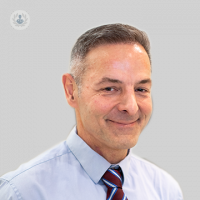Fat transfer for facial rejuvenation: how does it work?
Written in association with:As we age our skin and tissues in the face lose the ability to regenerate, therefore, we look to natural methods to fight those signs of ageing. Most recently, a fat transfer to the face is an alternative technique being used to restore volume and to give a youthful appearance to the visage. Here, one of our top London dermatologists Dr Aleksandar Godic explains just how the procedure works and how long the results last.

How does the fat transfer procedure work?
The fat cells that we all have also contain stem cells. When we harvest the stem cells and inject them, they can replace the lost volume in our face. They also keep our skin, muscles and bones regenerating and part of this is because the stem cells in the fat keep replicating in order to maintain new cells. The stem cells differentiate into the tissues that we need in the face, such as fat, bone, cartilage, muscle.
In addition, they keep producing growth factors, which are released on the sites of the injections. Those growth factors decrease inflammation of the tissue and also reduce the natural cell death.
Where is it most commonly used?
As we age, we are losing tissue in our face. We are losing bone, cartilage and muscle but especially fat. Fat is organised into little pads which are placed all over our face and as we get older, our face starts looking like a deflated balloon.
In order to replace this volume loss, we would use a fat transfer from our own body; usually from the abdomen. That's the one way that we can use those fat cells to replace the volume loss. Also, if you breakdown the fat cells, we get a lot of growth factors which contains within those fat cells. If we inject them on the skin surface, we can improve skin wrinkles and skin texture.
Normally, patients would see a dermatologist and get all other sorts of treatments, which requires a lot of patience and commitment. While by using our own fat, we can use only a few sessions and the results are permanent.
Where is the fat taken from?
We can usually do this procedure on-site on the day of the patient's visit. We would usually try to extract fat from the belly or sometimes we use inner thighs or, in men, we can take the fat on the back or on the back of the hand. Usually, we can extract quite enough amount of fat which further on can be processed and then injected into the face.
How long do results last?
Theoretically, results are permanent. Now, patients need probably two or three sessions and that's because when we inject for the first time, the volume is slightly decreased because the local anaesthetic and serum get washed off our face and the initial volume gets lessened.
We need to repeat this process on a monthly basis, probably two or three times. It depends on the age of the person and on the severity of signs of ageing. Once we achieve desirable results then that's permanent and not only permanent, as stem cell starts to replicate and produce new tissue. We theoretically can reverse the ageing and even stop it, which is a very new way of thinking.
Book an appointment with Dr Godic now if you are interested in having facial rejuvenation to combat signs of ageing!


